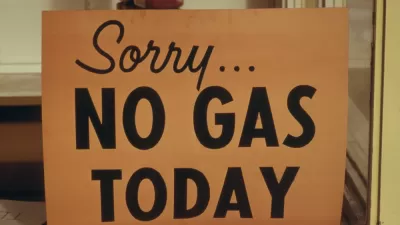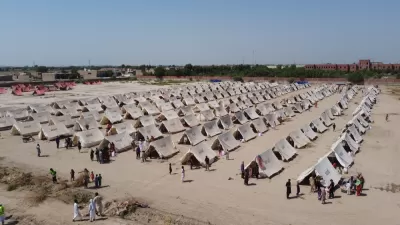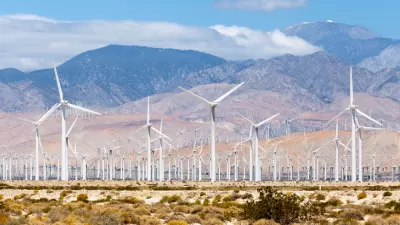The new report, Moving Cooler: Transportation Strategies to Reduce Greenhouse Gas Emissions, written by Cambridge Systematics and sponsored by a variety of organizations, identifies several dozen transportation climate change emission reduction strategies, including improvements to efficient modes (walking, cycling and public transit), pricing reforms and smart growth land use policies.
The new report, Moving Cooler: Transportation Strategies to Reduce Greenhouse Gas Emissions, written by Cambridge Systematics and sponsored by a variety of organizations, identifies several dozen transportation climate change emission reduction strategies, including improvements to efficient modes (walking, cycling and public transit), pricing reforms and smart growth land use policies. It evaluates their emission reductions, implementation costs, impacts on vehicle costs, and equity impacts, and estimates the emissions that could be reduced by various strategy packages.
It has already been criticized. Alan Pisarski considers the report to be full of exaggerations and misdirections, although the technical details of the report have yet to be released. He claims that the report was produced by a group of "progressive" foundations, new urbanists, planners and urban landowners (the report sponsors include the Intelligent Transportation Society of America; the Shell Oil Company and several federal agencies, and was recently endorsed by the Institute of Transportation Engineers), whose goal is price out of existence automobiles and suburban living. Pisarski's arguments represent the old transportation paradigm, which assumes that because mobility provides benefits, any effort to reduce mobility harms consumers and the economy, and that virtually everybody wants to live an automobile-dependent, suburban lifestyle.
A new transportation paradigm assumes that mobility is just one factor in achieving accessibility, that too much mobility can be as harmful as too little, and that demographic and economic trends are increasing the value of alternative modes and multi-modal communities. Pisarski made similar arguments in his January 2009 ITE Journal article The Nexus of Energy, Environment and the Economy: A Win, Win, Win Opportunity, which I responded to in a letter published in June, Response to Alan Pisarski's article ‘The Nexus of Energy, Environment and the Economy: A Win, Win, Win Opportunity'. These issues are discussed in more detail in my recent report, Are Vehicle Travel Reduction Targets Justified?
I certainly recognize the benefits of automobile travel and would agree that inappropriate vehicle travel reduction policies can be harmful. For example, it would be inefficient to arbitrarily forbid every third automobile trip or to allow traffic congestion to increase without providing alternatives. But Pisarski's assumption that any reduction in vehicle travel harms consumers and the economy is inaccurate. Most mobility management strategies evaluated in Moving Cooler reflect the principles of consumer sovereignty and economic efficiency: they improve transportation options (walking, cycling, public transit, carsharing, etc.); more efficiently price roads, parking and insurance; and create more accessible, multimodal communities. High value automobile travel will continue. It is wrong to claim that these reforms would eliminate automobile travel or suburban living.
Some of Pisarski's criticism is simply wrong. For example, he claims that Moving Cooler ignores carpooling, telecommuting and improved roadway operations, although these are given as much consideration as other strategies, and are supported by other strategies (for example, more efficient road and parking pricing give people more incentive to rideshare and telecommute). Like most critics, he ignores the significant co-benefits provided by most VMT reduction strategies, such as congestion reduction, road and parking facility cost savings, consumer savings, accident reductions, improved mobility for non-drivers, and improved public fitness and health.
Let me offer an economist's perspective of this issue. Transportation economists recognize that the demand curve for mobility has a long tail: if the price (user money and time costs) declines consumers will find reasons to continually increase their automobile travel, although an increasing portion of this travel has little net user benefit (consumer surplus), but impose external costs (congestion, road and parking facility costs not paid by users, uncompensated crash risk and damages, reduced mobility options for non-drivers, energy externalities, environmental damages). As a result, current North American transportation policies that minimize the price of driving result in a significant portion of vehicle travel with negative net value: benefits are less than total costs. Planning and pricing reforms that improve transport options and test consumers' willingness-to-pay for vehicle travel reduce lower value trips while allowing higher value trips to continue. In a more efficient transportation system consumers would likely choose to drive less, rely more on alternative modes, choose more accessible places to live and work, and be significantly better off overall as a result. This is described in detail the reports Are Vehicle Travel Reduction Targets Justified? and Socially Optimal Transport Prices and Markets.
Pisarski claims that increased automobile travel is critical to improve national productivity, but the evidence suggests otherwise. While a certain amount of mobility is necessary for economic development, research suggests that excessive automobile dependency is economically harmful because it increases total transportation costs, particularly petroleum import costs, and reduces agglomeration efficiencies. Increasing transportation system efficiency by improving transport options and more efficient pricing tends to increase productivity and economic development overall.
Pisarski also claims that, "most people, excepting a small but often very loud minority, opt for lower density living," implying that smart growth policies harm consumers. Yet, current housing market studies indicate that an increasing portion of households prefer living in more accessible, multi-modal neighborhoods, and this shift is likely to increase due to a combination of aging population, rising future fuel prices and increasing health and environmental concerns. Although demand for suburban living will not disappear, it is likely to grow much slower than demand for more compact housing in walkable and transit-oriented communities. Advocates of continued sprawl and automobile dependency appear to be expressing their own personal preferences rather than objective research.
Contrary to what critics claim, Moving Cooler is exactly the type of analysis we need to begin to identify the best emission reduction strategies.

Alabama: Trump Terminates Settlements for Black Communities Harmed By Raw Sewage
Trump deemed the landmark civil rights agreement “illegal DEI and environmental justice policy.”

Study: Maui’s Plan to Convert Vacation Rentals to Long-Term Housing Could Cause Nearly $1 Billion Economic Loss
The plan would reduce visitor accommodation by 25% resulting in 1,900 jobs lost.

Why Should We Subsidize Public Transportation?
Many public transit agencies face financial stress due to rising costs, declining fare revenue, and declining subsidies. Transit advocates must provide a strong business case for increasing public transit funding.

Paris Bike Boom Leads to Steep Drop in Air Pollution
The French city’s air quality has improved dramatically in the past 20 years, coinciding with a growth in cycling.

Why Housing Costs More to Build in California Than in Texas
Hard costs like labor and materials combined with ‘soft’ costs such as permitting make building in the San Francisco Bay Area almost three times as costly as in Texas cities.

San Diego County Sees a Rise in Urban Coyotes
San Diego County experiences a rise in urban coyotes, as sightings become prevalent throughout its urban neighbourhoods and surrounding areas.
Urban Design for Planners 1: Software Tools
This six-course series explores essential urban design concepts using open source software and equips planners with the tools they need to participate fully in the urban design process.
Planning for Universal Design
Learn the tools for implementing Universal Design in planning regulations.
Smith Gee Studio
Alamo Area Metropolitan Planning Organization
City of Santa Clarita
Institute for Housing and Urban Development Studies (IHS)
City of Grandview
Harvard GSD Executive Education
Toledo-Lucas County Plan Commissions
Salt Lake City
NYU Wagner Graduate School of Public Service






























